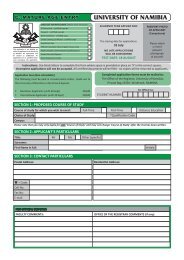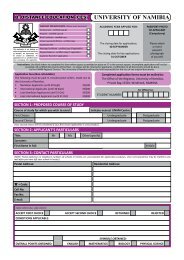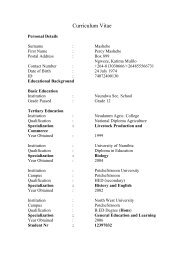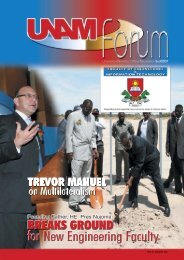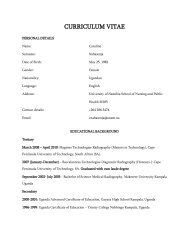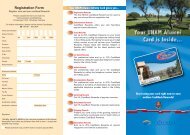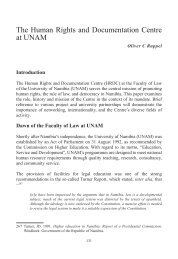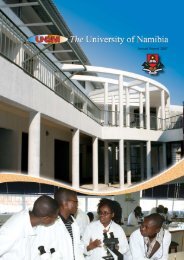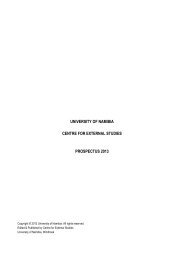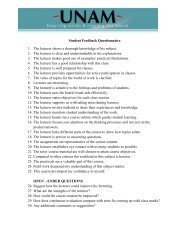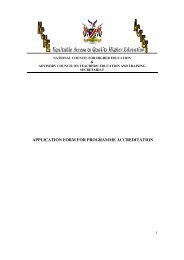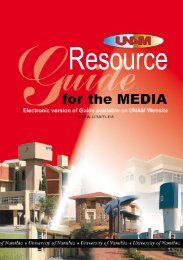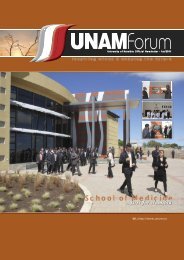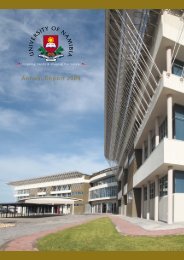SANUMARC Newsletter 2nd Edition - University of Namibia
SANUMARC Newsletter 2nd Edition - University of Namibia
SANUMARC Newsletter 2nd Edition - University of Namibia
Create successful ePaper yourself
Turn your PDF publications into a flip-book with our unique Google optimized e-Paper software.
BIOPLASTIC RESEARCH ATUNAM IN PARTNERSHIP WITHTHE AFRICA MATERIALSSCIENCE AND ENGINEERINGNETWORK (AMSEN)7ITING FROMMain Photo: John RittmannAfter a fourmonthGermancourse, allstudents arenow studying inselected Master’sdegree programsin Universities inBremen, Cottbus,Greifswaldand Kiel.AMSEN is one <strong>of</strong> five African networks that were selected for funding in 2008 bythe American-based Regional Initiative in Science and Education (RISE). The<strong>University</strong> <strong>of</strong> <strong>Namibia</strong> is one <strong>of</strong> five RISE networks in Africa. The other universitiesare Wits <strong>University</strong>, <strong>University</strong> <strong>of</strong> Botswana, <strong>University</strong> <strong>of</strong> Nairobi in Kenya andthe Federal <strong>University</strong> <strong>of</strong> Technology in the Nigerian city <strong>of</strong> Akure. RISE strives toassist participating African universities to develop and retain faculty membersthrough joint research, post-graduate training, sustainable collaboration andsmall grants for equipment, attending conferences and publication <strong>of</strong> findingsin peer reviewed journals. The fi rst AMSEN workshop was held in Windhoek in2010.At the recent <strong>2nd</strong> AMSEN workshop held in Kenya, Ms. Naomi Shifeta, a<strong>Namibia</strong>n MSc student funded by AMSEN delivered a proposal on theproduction <strong>of</strong> bioplastics from seaweed. Naomi will carry out her researchunder the supervision <strong>of</strong> Pr<strong>of</strong>. Frank Kavishe, the <strong>Namibia</strong>n node coordinatorfor AMSEN and co-supervised by Dr. Erold Naomab and Dr. Diina Shuuluka.The choice <strong>of</strong> Gracilaria for this research is due to their abundance alongthe southern <strong>Namibia</strong>n coastline and they contain agar, a natural polymermade from repeating units <strong>of</strong> galactose, which contain carbon and can beused to create a bioplastic. Agar is widely used particularly in the fi elds <strong>of</strong>biotechnology, food technology, and microbiology but not yet in the plasticindustry.Naomi’s research will be geared towards the development <strong>of</strong> a bioplasticusing agar from Gracilaria gracilis. It aims to create a bioplastic that will havecomparable tensile strength and chemical resistance to the petroleumbasedplastics in use today. This work will include harvesting Gracilaria fromthe fi eld, extracting its agar, manufacturing the bioplastic, and testing itsbiodegradability, tensile strength, and general chemical resistance. DrShuuluka, seaweed research expert at <strong>SANUMARC</strong>, noted that the outcome<strong>of</strong> this project will serve as a springboard for commercial cultivation andprocessing <strong>of</strong> seaweeds for the production <strong>of</strong> bioplastic, thereby adding valueto <strong>Namibia</strong>n seaweed resources.



